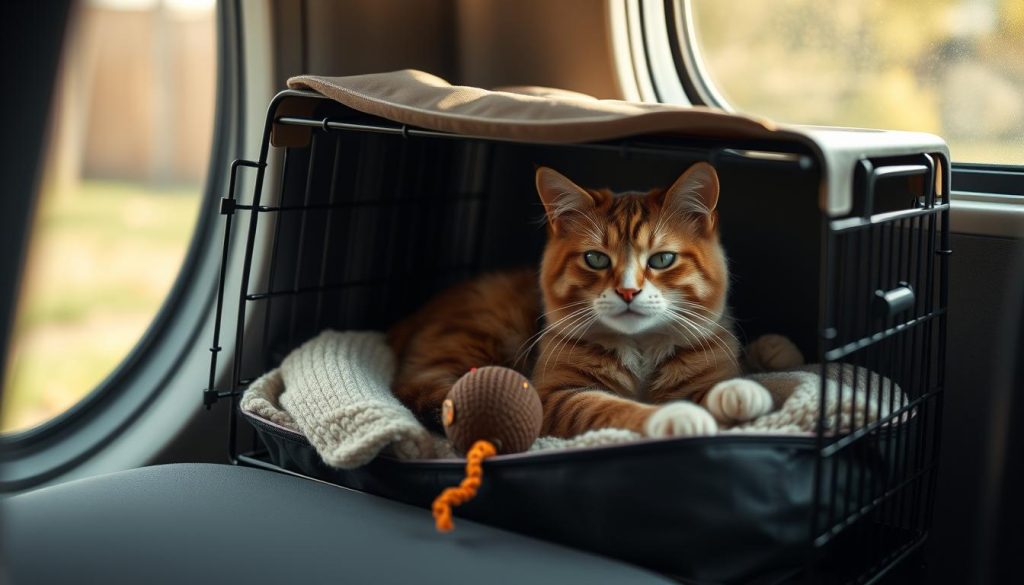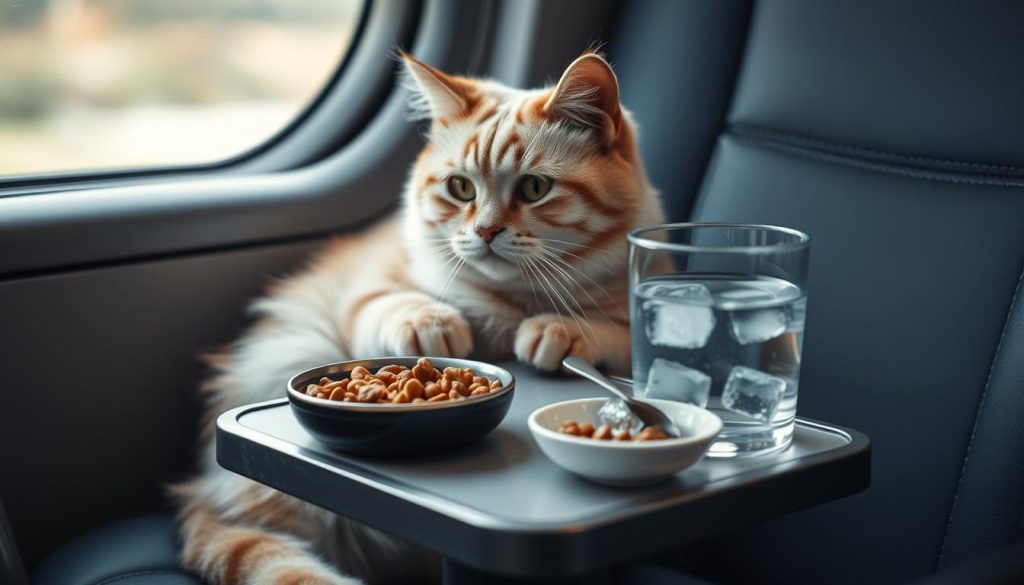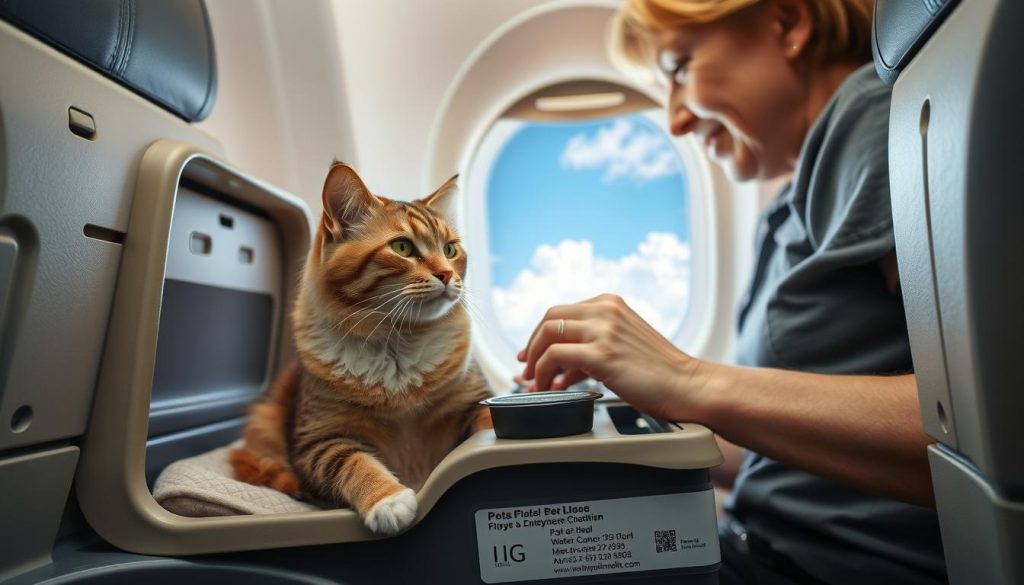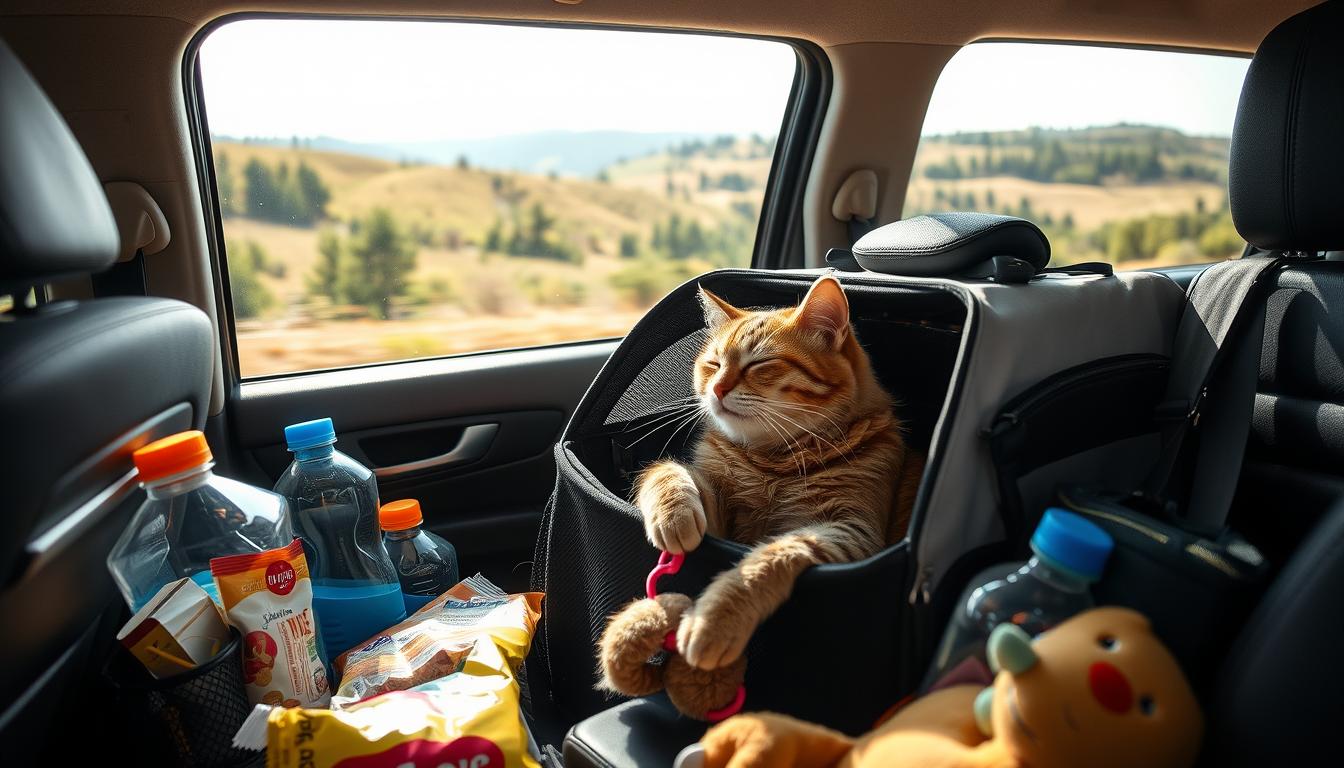As a proud pet parent, I know how important it is to care for our senior cats when we travel. Elderly cats need special care on trips. This guide will give you tips and advice for a smooth trip with your senior cat. We’ll cover everything from getting vet advice to finding the best places to stay.
Traveling with senior cats can seem tough, but with the right prep, it can be great for both you and your pet. Whether you’re moving or going on vacation, this article will help you keep your elderly cat safe and happy. You’ll learn how to make sure your cat is comfortable during the trip.
Seeking Veterinary Advice for Elderly Cat Travel
Before planning a trip for your senior cat, talk to your vet. They know best how to keep your cat safe and happy on the road.
Health Check and Recommendations
Get a full health check for your older cat to spot any health problems that could get worse with travel. Your vet can tell you the best ways to handle these issues. They’ll help make your cat’s trip comfy.
Medications and Supplements
Your vet might suggest certain medicines or supplements for your cat’s health during the trip. Make sure you have enough of these items to keep your cat well while traveling.
- Talk about any medicines your cat needs while traveling.
- Ask about supplements that can help your cat’s health and ease travel stress.
- Get any health papers or documents needed for your cat’s trip.
Working with your vet helps you make a travel plan that keeps your senior cat safe and happy. This way, your cat will have a smooth and worry-free trip.
Crate Training Your Senior Feline Companion

Crate training is key for traveling with your elderly cat. It makes them feel safe and comfy on the road. Start crate training weeks before your trip to help your cat get used to it.
Gradual Introduction to the Crate
First, put the crate in a quiet spot in your home. Make sure the door is open. Let your cat go in and out as they like.
Give them treats and say nice things when they go in. This makes them think the crate is a good place. Then, keep them in the crate for a little longer while you’re close by.
Crate Size and Amenities
Choose a crate that lets your senior cat stand, turn, and lie down easily. Put a soft blanket or bed inside for comfort. Add some of their favorite toys to make them feel calm during the trip.
With patience and positive rewards, crate training your elderly cat can make travel easier for them. Remember, the secret is to be patient and slowly get your cat used to the crate.
Choosing the Right Flight for elderly cat travel
Choosing the right airline for your senior cat is key. Not all airlines treat pets well, especially older cats. Look for ones that focus on keeping senior pets safe and comfy.
Some airlines offer special help for aging cats, like easy boarding and caring crew members. This is great for cats that get anxious or have trouble moving. Picking a carrier that thinks about elderly pets means your cat will feel safe and sound when it arrives.
Key Considerations for Elderly Cat Air Travel
- Research pet-friendly airlines that offer temperature-controlled cabins and regular pet checks during the flight
- Look for airlines with senior pet accommodations, such as priority boarding and attentive crew members
- Prioritize carriers that provide a calm and comfortable environment for your aging cat
- Avoid airlines with strict pet policies or limited pet-friendly amenities
Choosing the right airline for your senior cat reduces stress and discomfort. With a carrier that cares for your cat, your pet will travel safely and comfortably. This lets you relax on your trip, knowing your cat is well taken care of.
Preparing for the Journey: Food, Water, and Routine

Traveling with an elderly cat is tricky, especially with their eating and drinking needs. As cats get older, their stomachs can be more sensitive. So, planning ahead is key to keeping them comfortable on the trip.
Feeding Schedule and Hydration
Older cats like small, frequent meals. Give your senior cat a little bit of their usual food a few hours before you leave. Don’t feed them right before the flight to avoid motion sickness or stomach problems.
Make sure their water bowl is secure in the crate and full at the airport. To keep them hydrated, freeze water in the bowl before you go. It will melt slowly during the flight, giving your cat water as they need it.
Maintaining Daily Routine
Cats love routine, and changing it can stress them out, especially older ones. Try to keep their usual nap and play times during the trip. Bring their favorite toys, bedding, and treats to make the crate feel like home.
This way, you can make the trip easier for them and help them feel less anxious.
Avoiding Sedation and Exploring Calming Alternatives
Traveling with your elderly cat is important. Try not to use sedatives if you can. Sedatives can make it hard for your cat to control their body temperature at high places. Instead, look for ways to calm your cat naturally.
Using calming essential oils in your cat’s travel crate is a good idea. Oils like lavender or chamomile can make your cat feel calm. Also, bring things that smell like you or your home to make them feel safe.
- Avoid using sedatives or tranquilizers for elderly cats during travel
- Utilize calming essential oils in the travel crate to promote relaxation
- Bring familiar comfort items to help reduce stress and anxiety
Don’t use sedatives and try these gentle ways to calm your cat. This way, your senior cat will be more comfortable and safe on the trip. Remember, your cat’s happiness is most important. With some planning and creativity, you can ease their anxiety and make the trip easy for them.
Airline and Pet-Friendly Accommodations

Choosing the right airline for your elderly cat is key. Look for one with lots of pet experience and a controlled temperature. This keeps your senior cat comfy and safe on the trip. The airline should focus on pet safety with regular updates and a team watching over your cat.
Some airlines give special care to senior pets, like fast boarding and extra crew attention. This can really help reduce stress and keep your cat happy in the air.
Temperature-Controlled Environment
Keeping your elderly cat at a comfy temperature is vital. Extreme heat or cold can be hard on them. Make sure the airline has good climate control to keep your cat cozy during the flight.
Prioritizing Pet Safety
- Regular check-ins by the airline staff to monitor your cat’s well-being
- Dedicated team to provide special attention and care for senior pets during the flight
- Smooth and efficient boarding and handling procedures to minimize stress
Choosing a pet-friendly airline with good temperature control and safety is best. It makes sure your elderly cat travels comfortably and without stress.
Reducing Stress and Maintaining Calm
Traveling with your elderly cat is important for their comfort and well-being. Cats are very sensitive to how their owners feel. So, staying calm and positive helps your senior cat feel less stressed.
By managing your anxiety, you help your cat stay calm. This makes the trip better for both of you.
Owner’s Emotional State
Your cat notices how you feel. So, it’s key to keep stress down. Try deep breathing or meditation to stay calm. This helps your cat feel more secure.
Regular exercise and taking care of yourself also helps. It makes you feel better, which helps your cat too.
Familiar Scents and Comfort Items
Using familiar scents and items helps your senior cat feel safe. Bring their favorite blanket or toy. Or a piece of clothing with your scent.
These things make them feel more at home. You can also bring their litter box or some used litter. This helps them feel more secure in new places.
Looking after your feelings and using familiar items makes a big difference. It helps your elderly cat handle travel stress better. This approach makes the trip better for both of you.
Considering Professional Pet Relocation Services
Moving my elderly cat to another country is hard, especially with their health and happiness in mind. Luckily, professional pet relocation services can help. They give me the expert advice and support I need for a smooth move.
These services take care of all the paperwork and health checks. They also book the best transport for my cat. Plus, they help make the trip better for my cat, like picking the right crate and calming ways instead of sedation.
Choosing a trusted cat relocation service means my elderly cat is well cared for. I can focus on making my pet comfortable during the move. This way, I don’t have to worry about the details of moving my pet across borders.

